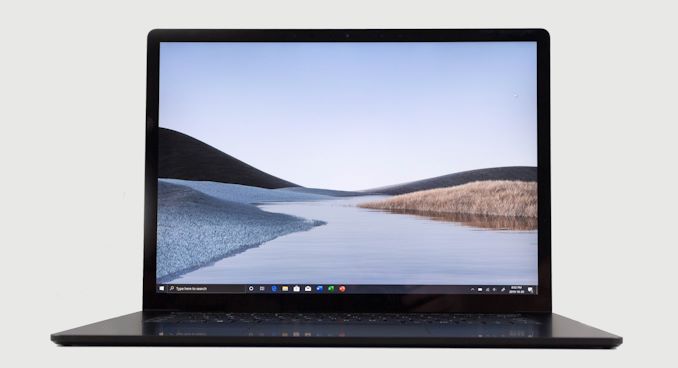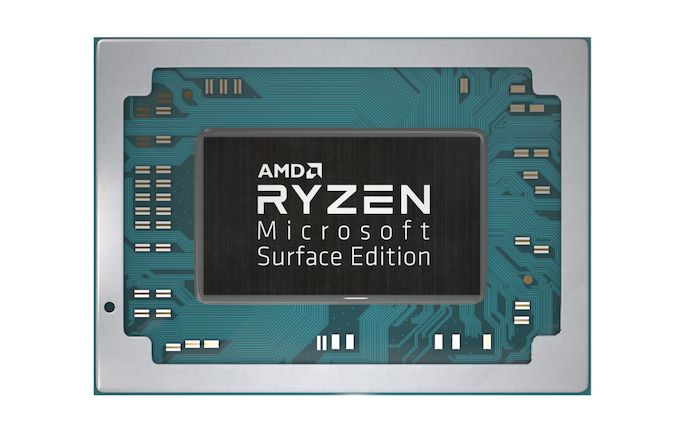The Microsoft Surface Laptop 3 Showdown: AMD's Ryzen Picasso vs. Intel's Ice Lake
by Brett Howse & Andrei Frumusanu on December 13, 2019 8:30 AM ESTFinal Words
Two laptops. Two platforms. It is rare to have a chance to see a manufacturer offer such equal footing to both AMD and Intel by outfitting a premium laptop with processors from both. It represents a rare opportunity to get to test the latest processors from AMD and Intel in a laptop in such an apples-to-apples fashion.
In the laptop space, design, cooling, and a manufacturers requirements can play a big part in how a particular chip performs, thanks to adjustable power level settings, surface temperature adjustments, and more. We have seen the lowest tier CPU outperform the highest tier CPU just by the virtue of a better cooling system, so to have processors from AMD and Intel, both of which launched in 2019, in the same chassis is a wonderful opportunity.
There aren’t too many ways to sugar coat the results of this showdown though. AMD’s Picasso platform, featuring its Zen+ cores and coupled with a Vega iGPU, has been a tremendous improvement for AMD. But Intel’s Ice Lake platform runs circles around it. Sunny Cove cores coupled with the larger Gen 11 graphics have proven to be too much to handle.
On the CPU side, no one should be too surprised by the results. We've already seen on the desktop that AMD’s Zen+ cores were competitive, but slightly slower than the previous Skylake platform; and the new Sunny Cove microarchitecture from Intel is a big step forward in terms of IPC for Intel. On purely CPU based tasks, Ice Lake really stretched its legs, and despite this being a 3.9 GHz chip, in single-threaded SPEC 2017, it managed to come very close to a 5.0 GHz Core i9-9900K with a massively higher TDP. Zen+ is outclassed here, and that showed in the benchmark results, and especially in the benchmark time. On our 8-thread SPEC 2017 run, the Ice Lake platform finished just a hair over two hours ahead of Picasso.
But things fare better for AMD on the GPU side of matters. Even though Intel has certainly closed the gap with Ice Lake's iGPU, AMD seems to continue to hold an advantage, especially on the 11 Compute Unit Ryzen Surface Edition processor found in the Surface Laptop 3. Intel has dedicated a lot more die area to the GPU and the results put them almost on equal footing with the Vega based GPU on Picasso. On the more complex GPU tasks, AMD tends to have a slight lead, and AMD’s low-level driver support also seems to benefit them on DirectX 12 based tasks. But, Ice Lake’s GPU is helped by the much quicker CPU it is coupled to, so depending on the specific test it can be even quicker.
Ice Lake does all of this with much better power efficiency as well. Overall battery life is quite a bit longer, and idle power draw is notably lower as well. Case in point: at minimum screen brightness, the Ice Lake system was pretty much only sipping power, drawing around 1.7 Watts, versus the 3.0 Watts for the AMD system.
It was fantastic to see AMD get a design win in a premium laptop this year, and the Surface Laptop 3 is going to turn a lot of heads over the next year. AMD has long needed a top-tier partner to really help its mobile efforts shine, and they now have that strong partner in Microsoft, with the two of them in a great place to make things even better for future designs. Overall AMD has made tremendous gains in their laptop chips with the Ryzen launch, but the company has been focusing more on the desktop and server space, especially with the Zen 2 launch earlier this year. For AMD, the move to Zen 2 in the laptop space can’t come soon enough, and will hopefully bring much closer power parity to Intel’s offerings as well.
Meanwhile for Intel, Ice Lake has been years in the making, and, after a long delay, it is finally here. After digging into the platform in-depth, it’s clear that Ice Lake is an incredibly strong offering from Intel. The CPU performance gains are significant, particularly because they were made in the face of a CPU frequency deficit. But the biggest gains were on the GPU side, where Intel’s Gen 11 GT2 in its full 64 Execution Unit configuration is likely the biggest single increase in GPU performance since they started integrating GPUs. It pulls very close to AMD’s Vega, closing the gap in performance to almost zero.
2019 has been a big year in the laptop space, with both Intel and AMD bringing new tools to the game. 2020 should be just as exciting, and if we’re lucky, we’ll get another chance to do this all over again.













174 Comments
View All Comments
serendip - Saturday, December 14, 2019 - link
The pricing borders on the ridiculous for the AMD version of the SL3, on top of the Ice Lake variant not being available for consumers. I'm all for competition in the mobile chip arena but Ryzen Picasso is uncompetitive at $2000. Microsoft really made a mess this time. But then again, the 15" SL3 is a niche of a niche product, so they could be using this as an experiment for AMD on the next Surface Pro.MBarton - Monday, December 30, 2019 - link
The only reason Microsoft is using leftover Zen Picasso parts is because Intel's 10nm is so pathetic that they can't get enough working Intel parts to supply demand. So Microsoft got a cheap deal on old Zen+ parts to help fill the void. Low margin mobile CPU markets are not what AMD is focused on. AMD needs money and the profits are in the server market and HEDT market.Jhlot - Sunday, December 15, 2019 - link
"On purely CPU based tasks, Ice Lake really stretched its legs, and despite this being a 3.9 GHz chip, in single-threaded SPEC 2017, it managed to come very close to a 5.0 GHz Core i9-9900K with a massively higher TDP.Sunny Cove cores on Desktop are going to very good if Intel can get the darn things out.
eastcoast_pete - Sunday, December 15, 2019 - link
Maybe somebody at AT or here knows, but my favorite suspicion why MS even had a Ryzen mobile system on offer despite it being a full generation behind is that they didn't trust Intel getting their 10 nm Ice Lake fabbing straightened out in time, and didn't want to risk getting caught without pants. In other words, was this MS playing it safe with the AMD APU as second option just in case Intel came up short again? What's the word?heffeque - Sunday, December 15, 2019 - link
This sounds very plausible.MBarton - Monday, December 30, 2019 - link
Intel HASN'T gotten their 10nm Ice Lake "straightened out". Hence why Intel is suddenly mum on Ice Lake server parts. They've totally disappeared from presentations. Why anybody thought that Intel would get ICL "straightened out" now, out of the blue, is beyond me. 10nm is essentially dead.AntonErtl - Sunday, December 15, 2019 - link
As long as the Ryzen U chips don't get competetive idle power consumption, they will have a severe handicap in the laptop market. But for small fanless barebones systems (e.g., something like the Zotac ZBOX CI series), they should be quite appropriate. I wonder why we don't see them in that capacity.Farfolomew - Sunday, December 15, 2019 - link
10th Gen Comet Lake CPUs are better than Ryzen 3k APUs. Of course Ice Lake is going to dominate. Zen 3 better be decent to compete with Icelake on desktop.scineram - Monday, December 16, 2019 - link
What Icelake on desktop?maroon1 - Tuesday, December 17, 2019 - link
We won't see icelake on desktop even next year